So-called psychic phenomena, and mysticism probably emanate as energies with vibratory rates faster than the speed of light. Hence, they are non-physical forces. My evolving project may have some relevance here too http://www.p2pfoundation.net/Multi-Dimensional_Science
RS
RS
(Redirected from Faster-than-light communication) Wikipedia
Superluminal communication is the hypothetical process by which one might send information at faster-than-light (FTL) speeds.
Some theories and experiments include:
If wormholes are possible, then ordinary subluminal methods of communication could be sent through them to achieve superluminal transmission speeds. Considering the immense energy that current theories suggest would be required to open a wormhole large enough to pass spacecraft through it may be that only atomic-scale wormholes would be practical to build, limiting their use solely to information transmission. Some theories of wormhole formation would prevent them from ever becoming "timeholes", allowing superluminal communication without the additional complication of allowing communication with the past.[citation needed]
In standard quantum mechanics, it is generally accepted that the no cloning theorem prevents superluminal communication via quantum entanglement alone, leading to the no-communication theorem. Consider the EPR thought experiment, and suppose quantum states could be cloned. Alice could send bits to Bob in the following way:
Although such communication is prohibited in the thought experiment described above, some argue that superluminal communication could be achieved via quantum entanglement using other methods that don't rely on cloning a quantum system. One suggested method would use an ensemble of entangled particles to transmit information,[3] similar to a type of quantum eraser experiments.[4][5][6] As the quantum eraser experiments rely on a classical, subluminal channel for coincidence detection, it is unclear whether superluminal communication would be possible by this method. Physicist John G. Cramer at the University of Washington is attempting to replicate one of these experiments and demonstrate whether or not it can produce superluminal communication.[7][8]
Some theories and experiments include:
- Group velocity > c experiments
- Evanescent wave coupling
- Tachyons
- Quantum nonlocality
If wormholes are possible, then ordinary subluminal methods of communication could be sent through them to achieve superluminal transmission speeds. Considering the immense energy that current theories suggest would be required to open a wormhole large enough to pass spacecraft through it may be that only atomic-scale wormholes would be practical to build, limiting their use solely to information transmission. Some theories of wormhole formation would prevent them from ever becoming "timeholes", allowing superluminal communication without the additional complication of allowing communication with the past.[citation needed]
In standard quantum mechanics, it is generally accepted that the no cloning theorem prevents superluminal communication via quantum entanglement alone, leading to the no-communication theorem. Consider the EPR thought experiment, and suppose quantum states could be cloned. Alice could send bits to Bob in the following way:
-
- If Alice wishes to transmit a '0', she measures the spin of her electron in the z direction, collapsing Bob's state to either |z+>B or |z->B. If Alice wishes to transmit a '1', she measures the spin of her electron in the x direction, collapsing Bob's state to either |x+>B or |x->B. Bob creates many copies of his electron's state, and measures the spin of each copy in the z direction. If Alice transmitted a '0', all his measurements will produce the same result; otherwise, his measurements will be split evenly between +1/2 and -1/2. This would allow Alice and Bob to communicate across space-like separations.
Although such communication is prohibited in the thought experiment described above, some argue that superluminal communication could be achieved via quantum entanglement using other methods that don't rely on cloning a quantum system. One suggested method would use an ensemble of entangled particles to transmit information,[3] similar to a type of quantum eraser experiments.[4][5][6] As the quantum eraser experiments rely on a classical, subluminal channel for coincidence detection, it is unclear whether superluminal communication would be possible by this method. Physicist John G. Cramer at the University of Washington is attempting to replicate one of these experiments and demonstrate whether or not it can produce superluminal communication.[7][8]
[edit] References
- ^ Feinberg, Gerald (1967). "Possibility of Faster-Than-Light Particles". Physical Review 159 (5): 1089–1105. Bibcode 1967PhRv..159.1089F. doi:10.1103/PhysRev.159.1089.
- ^ Peacock, K.A.; Hepburn, B. (1999). "Begging the Signaling Question: Quantum Signaling and the Dynamics of Multiparticle Systems". Proceedings of the Meeting of the Society of Exact Philosophy.
- ^ Millis, M.G.; Davis, E.W., eds. (2009). Frontiers of Propulsion Science. Progress in astronautics and aeronautics. American Institute of Aeronautics and Astronautics. pp. 509–530.
- ^ Strekalov, D.; Sergienko, A.; Klyshko, D.; Shih, Y. (01 May 1995). "Observation of Two-Photon "Ghost" Interference and Diffraction". Physical Review Letters 74 (18): 3600–3603. doi:10.1103/PhysRevLett.74.3600. PMID 10058246. http://people.bu.edu/ALEXSERG/Ghost.pdf.
- ^ Dopfer, Birgit (1998). PhD Thesis. Univ. Innsbruck.
- ^ Zeilinger, Anton (1999). "Experiment and the foundations of quantum physics". Reviews of Modern Physics 71 (2): 288–297. doi:10.1103/RevModPhys.71.S288. http://qudev.ethz.ch/content/courses/phys4/studentspresentations/epr/zeilinger.pdf.
- ^ Paulson, Tom (14 November 2006). "Going for a blast into the real past". Seattle Post-Intelligencer. http://www.seattlepi.com/default/article/Going-for-a-blast-into-the-real-past-1219821.php. Retrieved 11 July 2011.
- ^ Barry, Patrick (September 30, 2006). "What's done is done… or is it?". New Scientist 191 (2571): 36–39. http://www.newscientist.com/article/mg19125710.900-whats-done-is-done133-or-is-it.html. (subscription required)
[edit] See also
- Ansible
- Bell test experiments
- Delayed choice quantum eraser
- Faster-than-light
- Light
- Quantum teleportation
- Speed of light
- Synchronicity
- Ultrawave

No comments:
Post a Comment